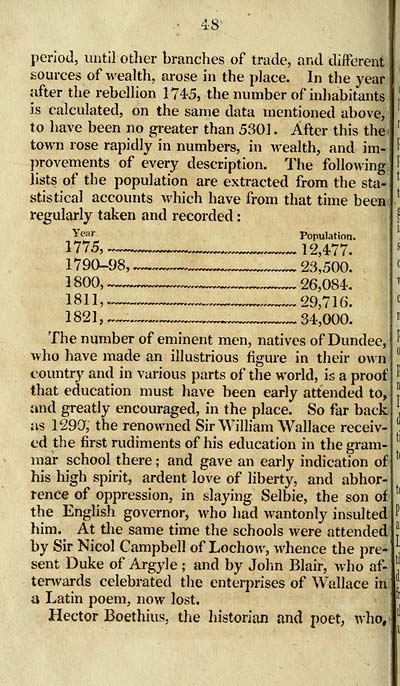Towns > Dundee > 1822 - Dundee delineated; or, A history and description of that town, its institutions, manufactures and commerce
(50)
Download files
Complete book:
Individual page:
Thumbnail gallery: Grid view | List view

• 48
period, until other branches of trade, and different !
sources of wealth, arose in the place. In the year
after the rebellion 1745, the number of inhabitants
is calculated, on the same data mentioned above,
to have been no greater than 5301 . After this the
town rose rapidly in numbers, in wealth, and im-
provements of every description. The following
lists of the population are extracted from the sta-
stistical accounts which have from that time been
regularly taken and recorded :
^ ear Population.
1790-98, ^.ZZZZZZZZI 2s',50o!
1800, 26,084.
1811, 29,7 1 6.
1821, ~~ 34,000.
The number of eminent men, natives of Dundee,
who have made an illustrious figure in their own
country and in various parts of the world, is a proof
that education must have been early attended to,
and greatly encouraged, in the place. So far back
as 1290, the renowned Sir William Wallace receiv-
ed the first rudiments of his education in the gram-
mar school there ; and gave an early indication of
his high spirit, ardent love of liberty, and abhor-
rence of oppression, in slaying Selbie, the son of
the English governor, who had wantonly insulted
him. At the same time the schools were attended
by Sir Nicol Campbell of Lochow, whence the pre-
sent Duke of Argyle ; and by John Blair, who af-
terwards celebrated the enterprises of Wallace in
a Latin poem, now lost.
Hector Boethius, the historian and poet, who,
period, until other branches of trade, and different !
sources of wealth, arose in the place. In the year
after the rebellion 1745, the number of inhabitants
is calculated, on the same data mentioned above,
to have been no greater than 5301 . After this the
town rose rapidly in numbers, in wealth, and im-
provements of every description. The following
lists of the population are extracted from the sta-
stistical accounts which have from that time been
regularly taken and recorded :
^ ear Population.
1790-98, ^.ZZZZZZZZI 2s',50o!
1800, 26,084.
1811, 29,7 1 6.
1821, ~~ 34,000.
The number of eminent men, natives of Dundee,
who have made an illustrious figure in their own
country and in various parts of the world, is a proof
that education must have been early attended to,
and greatly encouraged, in the place. So far back
as 1290, the renowned Sir William Wallace receiv-
ed the first rudiments of his education in the gram-
mar school there ; and gave an early indication of
his high spirit, ardent love of liberty, and abhor-
rence of oppression, in slaying Selbie, the son of
the English governor, who had wantonly insulted
him. At the same time the schools were attended
by Sir Nicol Campbell of Lochow, whence the pre-
sent Duke of Argyle ; and by John Blair, who af-
terwards celebrated the enterprises of Wallace in
a Latin poem, now lost.
Hector Boethius, the historian and poet, who,
Set display mode to: Large image | Transcription
Images and transcriptions on this page, including medium image downloads, may be used under the Creative Commons Attribution 4.0 International Licence unless otherwise stated. ![]()
| Scottish Post Office Directories > Towns > Dundee > Dundee delineated; or, A history and description of that town, its institutions, manufactures and commerce > (50) |
|---|
| Permanent URL | https://digital.nls.uk/85824631 |
|---|
| Description | Directories of individual Scottish towns and their suburbs. |
|---|
| Description | Around 700 Scottish directories published annually by the Post Office or private publishers between 1773 and 1911. Most of Scotland covered, with a focus on Edinburgh, Glasgow, Dundee and Aberdeen. Most volumes include a general directory (A-Z by surname), street directory (A-Z by street) and trade directory (A-Z by trade). |
|---|


